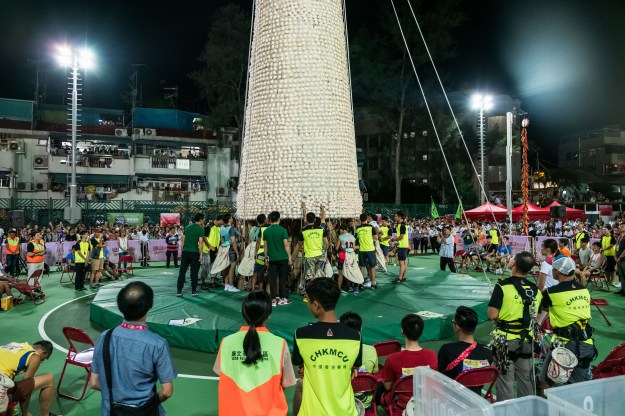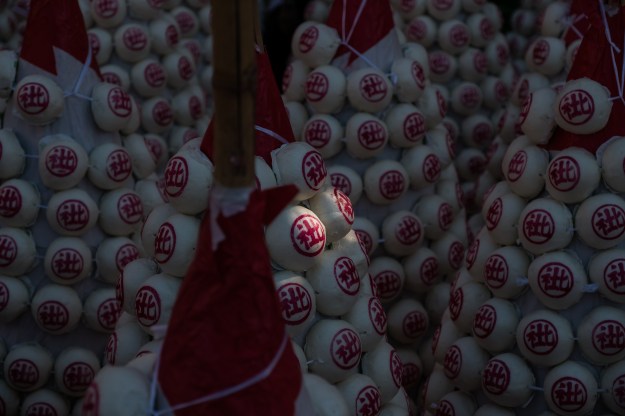For a few days every May, sleepy Cheung Chau—a tiny island about 40 minutes from Hong Kong’s Central district—turns into the most crowded and chaotic place in Hong Kong as tens of thousands of visitors descend on the island for its annual Cheung Chau Bun Festival.
Added to China’s Intangible Cultural Heritage list in 2011, the annual festival celebrates ping on bao (lucky buns) and is a whirlwind of Cantonese opera performances, lion dances, parades, and the grand finale: a bun scrambling race that sees competitors scale a 45-foot-tall tower and snatch as many ping on bao as possible.
The event began more than a century ago when the island was struck with a devastating plague, according to local lore. “Citizens thought the gods or ghosts were spreading the disease,” explains Martin Kwok, the second-generation owner of Kwok Kam Kee bakery, which specializes in ping on bao. “The people thought maybe the ghosts were hungry, so that’s why they started making sesame-paste-filled lucky buns.”
Villagers also built an altar for Pak Tai, a Taoist deity, to appeal for help, then paraded through the streets wearing costumes to drive away evil spirits. Now known as the Piu Sik (Floating Colors) Parade, this carnival-like procession—which features gongs, drums, lion dances, effigies, and costumed children—takes place several hours before the scrambling bun competition and passes through the island’s narrow alleyways, leaving colorful scraps of papier-mâché in its wake.



“The costumes are usually satirical, often celebrities and political personalities,” says Kwok. “The idea being, if they feed and entertain the ghosts, then the ghosts won’t spread the diseases anymore.”
After a few years, the maladies went away, but villagers continued to parade and bake buns each year as they prayed for health and luck. Over time, the bun festival evolved from a local ritual to a massive annual celebration. This year’s festival swelled with more than 40,000 visitors—more than twice the island’s population.
It’s all hands on deck for local bakeries like Kwok Kam Kee, which churned out upward of 80,000 ping on bao during this year’s festival. Each steamed bao arrives stamped with a red Chinese character meaning “peace” and filled with sesame, red bean, or lotus seed paste. This year the bakery introduced Hello Kitty–themed ping on bao packed with ube (purple yam) and matcha.

Kwok has worked in his family’s shop for more than 10 years and usually helps during the bakery’s busiest time of the year. “We used to hire at least a dozen [bun-wrapping] masters to come and wrap all the buns by hand during the festival, but we recently bought some machines to help with production,” Kwok says. “The most important thing to understand is that the buns are much more than snacks. They symbolize peace and luck and blessings.”
After the parade, the crowd makes its way to the island’s soccer field. It’s time for the main event: the bun scrambling competition. Four enormous towers fill the square. Three are for decoration, each studded with 20,000 ping on bao, and the fourth—and tallest—is an A-shaped steel mammoth, constructed just for this event.
Just before 11:30 p.m., 12 competitors gather around the base of the tallest tower as thousands of fans look on. The crowd begins counting down to midnight in unison, nearly drowning out the gong that signals the start of the race. Climbers have three minutes to race up the tower and collect as many buns as possible—the higher the buns, the better. Buns on the lowest section of the tower are worth one point; the middle, three; and the top, nine. After three minutes, they rappel back to the ground and count up their points. The male and female climbers with the highest tallies take home trophies and good luck for the year to come.



The race is said to have evolved from the tradition of leaving mountains of offerings at the Pak Tai Temple. Earlier races were a free-for-all: Anyone who wanted could join the competition, and hundreds of participants used to swarm atop a bamboo mountain of buns, grabbing as many as possible. But after a tower toppled under the weight of 200 bun grabbers in 1978, injuring at least 100 people, the government retired the chaotic competition.
Officials lifted the ban in 2005, with a few added safety precautions: the bamboo tower was replaced with steel, and participants must qualify to be among the 12 final competitors. Also, organizers eschewed edible ping on bao for plastic ones to curb food waste.
In the weeks leading up to the final, roughly 200 aspiring bun snatchers compete in a two-part selection process. They arrive kitted out with ropes and harnesses for climbing, gloves for grip, and a white bag to fill with buns.

A five-time scramble champion, Angel Wong Ka-yan, holds the women’s record with 747 points in one event. “The first year, I just watched everything close up from the sideline,” says Wong. “They were still using real buns at the time, and I remember the sound they made when they fell on the ground. The thud was like thunder.”
In 2010 she competed for the first time and won, taking home the title of Queen of the Buns. “I never imagined winning, and even when I got into the semifinals, I was very nervous. I wanted to win the trophy for my family because 平安 (loosely meaning peace and safety) is written on the cup. That is very important to a traditional Chinese family like mine.”
Also among the competitors at this year’s event, Wong was met with a surprise disqualification as she did not make it back to the ground within the 3-minute mark. Even as a competitive rock climber, Wong says, the race is a challenge. “The climbing techniques and bun scrambling techniques are quite similar to rock climbing,” she says. “For the bun scramble, the first thing to keep in mind during the race is speed. You have to be able to move fast in order to go from the ground to the top in seconds.”
But she says the race is more than just a game; it’s also about local traditions, the meaning of the buns, and the excited crowd. “When I see foreigners at the event, I always think their reaction is just like mine the first time I saw the competition,” says Wong. “Their eyes seem to fill with awe. I’m excited too, knowing that they came from so far away just to watch the competition.”
As the winners are crowned and the finale winds down, the crowd makes its way back to Hong Kong Island. With its peace and health restored, the sleepy island waits quietly for the festivities to begin again next year.
